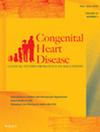婴儿和儿童先天性冠状动脉照相机瘘管经导管闭合的中期和长期随访:来自单一中心的经验
IF 1.2
4区 医学
Q4 CARDIAC & CARDIOVASCULAR SYSTEMS
引用次数: 0
摘要
背景:关于儿科患者冠状动脉cameral瘘管(CCFs)经导管闭合(TCC)的中期和长期结果的数据有限。方法:回顾性纳入2005年至2019年期间所有诊断为CCFs并计划接受TCC的儿科患者。结果:共有66例患者(中位年龄:3.93岁,中位体重:15 kg)接受了CCFs的TCC尝试。62例患者立即成功植入器械,44例患者立即完全闭塞(44/62%,71.0%)。由于解剖原因,2例患者放弃了闭合手术。5例患者术中共发生急性心肌梗死(n = 3)、术中死亡(n = 1)、器械栓塞(n = 1)、腱索断裂(n = 1)等6个围手术期并发症,急性手术成功率为89.4%(59/66),急性并发症发生率为9.1%(6/66)。62例患者中有58例(93.5%)收集了随访数据,中位时间为9.3年(范围3.0-15.7年)。9例患者发生10例不良事件,其中随访并发症5例(1例主动脉瓣穿孔、1例冠状动脉血栓形成、1例再介入后进行性动脉瘤扩张、2例新发三尖瓣脱垂伴明显返流),5例闭合失败伴大量分流残留。中长期不良事件发生率为17.2%(10/58)。与急性和随访不良事件相关的解剖学特征是大CCFs (p = 0.005)和巨大冠状动脉动脉瘤(CAAs) (p = 0.029)。结论:婴儿和儿童CCFs的TCC似乎是有效的,并且并发症发生率相对较低。大型ccf和大型caa在关闭后的急性、中期和长期不良事件风险较高。本文章由计算机程序翻译,如有差异,请以英文原文为准。
Intermediate and Long-Term Follow-Up of Transcatheter Closure of Congenital Coronary Cameral Fistulas in Infants and Children: Experience from a Single Center
Background: Limited data are available regarding intermediate and long-term outcomes of transcatheter closure (TCC) of coronary cameral fistulas (CCFs) in the pediatric patients. Methods: All pediatric patients diagnosed with CCFs who were scheduled to undergo TCC between 2005 and 2019 were retrospectively enrolled in the study. Results: A total of 66 patients (median age: 3.93 years, median weight: 15 kg) underwent attempted TCC of CCFs. Immediate successful device implantation was achieved in 62 patients, and immediate complete occlusion was achieved in 44 patients (44/62%, 71.0%). The closure procedure was waived in 2 patients due to anatomical factors. A total of 6 periprocedural complications occurred in 5 patients, including acute myocardial infarction (n = 3), procedure-related death (n = 1), device embolization (n = 1), and rupture of tricuspid chordae tendineae (n = 1). The acute procedural success rate was 89.4% (59/66), while the acute complication rate was 9.1% (6/66). Follow-up data were collected for 58 (93.5%) out of 62 patients at a median of 9.3 years (range: 3.0–15.7 years). 10 adverse events occurred in 9 patients, including 5 follow-up complications (1 aortic valve perforation, 1 coronary thrombosis, 1 progressive aneurysmal dilation after reintervention, and 2 cases of new-onset tricuspid valve prolapse with significant regurgitation), and 5 closure failure with large residual shunts. The intermediate and long-term adverse event rate was 17.2% (10/58). The anatomical features associated with both acute and follow-up adverse events were large CCFs (p = 0.005), and giant coronary artery aneurysms (CAAs) (p = 0.029). Conclusions: TCC of CCFs in infants and children appears to be effective and is associated with a relatively low complication rate. Large CCFs and giant CAAs represent a higher risk of both acute and intermediate and long-term adverse events after closure.
求助全文
通过发布文献求助,成功后即可免费获取论文全文。
去求助
来源期刊

Congenital Heart Disease
CARDIAC & CARDIOVASCULAR SYSTEMS-
CiteScore
0.40
自引率
33.30%
发文量
37
审稿时长
6-12 weeks
期刊介绍:
Congenital Heart Disease is an open-access journal focusing on congenital heart disease in children and adults. Though the number of infants born with heart disease each year is relatively small (approximately 1% of the population), advances in treating such malformations have led to increased life spans for this population. Consequently, today most patients treated for congenital heart disease are over the age of 20. What are the special needs of adults with congenital heart disease? What are the latest developments in the care of the fetus, infants, and children? Who should treat these patients? How should they be treated?
Congenital Heart Disease focuses on these questions and more. Conceived as a forum for the most up-to-date information on congenital heart disease, the journal is led by Editor-in-Chief Vladimiro L. Vida, MD, Ph.D., Professor in Cardiac Surgery, University of Padua in Italy, as well as an international editorial board. Congenital Heart Disease publishes articles on heart disease as it relates to the following areas:
• Basic research of congenital heart disease
• Clinical pediatric and adult cardiology
• Cardiac imaging
• Preventive cardiology
• Diagnostic and interventional cardiac catheterization
• Electrophysiology
• Surgery
• Long-term follow-up, particularly as it relates to older children and adult congenital heart disease
• Exercise and exercise physiology in the congenital patient
• Post-op and critical care
• Common disorders such as syncope, chest pain, murmurs, as well as acquired disorders such as Kawasaki syndrome
The journal includes clinical studies, invited editorials, state-of-the-art reviews, case reports, articles focusing on the history and development of congenital heart disease, and CME material. Occasional issues focus on special topics.
Readership: Congenital Heart Disease was created for pediatric cardiologists; adult cardiologists who care for patients with congenital heart disease; pediatric and pediatric cardiology nurses; surgeons; radiologists; anesthesiologists; critical care physicians and nurses; and adult support staff involved in the care of patients with congenital heart disease.
 求助内容:
求助内容: 应助结果提醒方式:
应助结果提醒方式:


